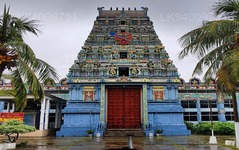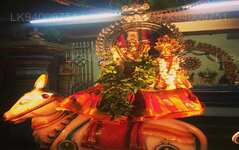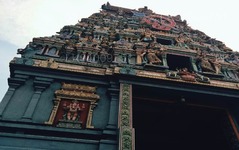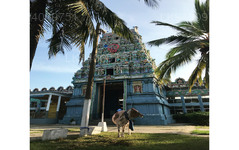
Città di Colombo
Colombo, la capitale dello Sri Lanka, è una città dinamica che fonde tradizione e modernità. Vanta un'architettura coloniale, vivaci mercati e sereni templi buddisti. Con una cucina variegata, uno skyline in continua crescita e splendide spiagge, è un vivace centro per gli affari, la cultura e il turismo, offrendo un punto di partenza ideale per esplorare le meraviglie dello Sri Lanka.
Old Kathiresan Temple
Old Kathiresan Temple is a massive century old Hindu cultural site hidden amongst the busy business centre of Colombo City. It is located in Colombo 4 (Bambalapitiya) a little further on from the twin Hindu Temples opposite the Bambalapitiya Apartment Complex, and is adjoining Vajira Road.
Kathiresan (Light Rayed Lord) is another name for Lord Murugan, the Hindu God of Light, Love and War. Wen the temple was initially built, Lord Murugan was considered the main deity of the temple and enshrined in the central shrine. As such it gained the name Kathiresan Temple. With the building of another Murugan Temple nearby (the one directly opposite the apartments mentioned before), which was named New Kathiresan Temple,, this one began to be called Old Kathiresan temple to differentiate it. In addition, with time the temple,s Ganesha shrine became highly popular and earned the place the name Vajira Road Pillaiyar (Ganesha) Kovil, or ‘Vijira Pilaiyar Kovil,..
While the Old Kathiresan Temple is quite old and has a long history, it remains a quiet place of peace and solace. One of the reasons for this is that it is still not as popular as the nearby temples, as the temple only opened back up recently after a very long stint of renovations. For the youth of Colombo, this temple is pretty much unknown place as it has remained under construction for over a decade.
However, now that it has opened its doors to devotees once again, the work done on the temple has been found to be amazing. A beautiful green lawn and a tall colorful temple tower welcome The new coats of paint add a touch of color to the temple,s original structure. Many new additions have been made with an impeccable eye to detail. The deities in the shrines are beautifully carved and in some shrines, where they were initially too small or crudely made, replaced with black granite statues from India done by master stone carvers.
Visiting the Temple
When visiting Hindu temples it is a custom to cleanse yourself properly and wear clean washed clothes when visiting, as they are holy places. You can also take offerings such as flowers, incense sticks, garlands, silk or satin cloth for draping the deities, etc. There are usually garland sellers near the entrance of the temple who sell many types of offerings.
Before entering the temple remove your footwear and hand it over to the person who handles this near the entrance. Wash your feet at the tap close to where your footwear is kept, to cleanse them. Also wash your offerings if they are washable (garlands or flowers), or sprinkle some fresh clean water if not.
Once you enter you will be faced with the main shrine. After giving your offerings you can buy a ticket for a pooja. They will ask for your name and astrological birth star. If you don’t know your star, you can just give your name. Then there will be a pooja and some blessed pooja objects (a banana on a betel leaf, holy ash, flowers from the pooja, etc) will be given to you to take home.
You can then move clockwise around the rest of the temple looking at the other shrines, such as the Ganesha and Shiva shrines. You can also request to do poojas at the other shrines with purchased tickets from the counter inside if you wish. Towards the back you will come to a shrine with some recent Indian saints: Sai Baba and Shirti Sai Baba. If you are a believer in these saints, you may enjoy a visit here.
There are also some cows and roosters at the temple. The cows are used to provide milk for the poojas, while the roosters are kept because they have special significance to the main deity of the temple Murugan. According to legend, Lord Murugan battled an evil demon to save the people of heaven and earth. During the battle the demon attempted to escape by hiding in the form of a mango tree. But it was discovered, and Murugan split the demon into two with his spear. One of the split parts turned into a peacock, and the other a rooster. The peacock became Murugan,s vehicle for travel, while the colorful rooster became his flag. Hence, this Murugan temple – like many others – has roosters walking around with great aplomb.
There is much to see and enjoy at this temple. It makes for a pleasant space of worship and solace in a city of bustling tradespeople and workers.
Informazioni sul distretto di Colomb
Colombo è la città più grande e la capitale commerciale dello Sri Lanka. Si trova sulla costa occidentale dell'isola e adiacente a Sri Jayewardenepura Kotte, la capitale dello Sri Lanka. Colombo è una città vivace e trafficata, con un mix di vita moderna, edifici e rovine coloniali e una popolazione di 647.100 abitanti. La regione metropolitana di Colombo, definita dai distretti di Colombo, Gampaha e Kalutara, ha una popolazione stimata di 5.648.000 abitanti e si estende su una superficie di 3.694,20 km². Colombo è una città multietnica e multiculturale. È la città più popolosa dello Sri Lanka, con 642.163 abitanti che vivono entro i confini della città. La popolazione di Colombo è un mix di numerosi gruppi etnici, principalmente cingalesi, mori e tamil. In città vivono anche piccole comunità di persone di origine cinese, portoghese, olandese, malese e indiana, oltre a numerosi espatriati europei. La stragrande maggioranza delle aziende dello Sri Lanka ha sede a Colombo. Alcuni dei settori industriali includono prodotti chimici, tessili, vetro, cemento, pelletteria, arredamento e gioielleria. Nel centro città si trova il secondo edificio più alto dell'Asia meridionale: il World Trade Center.
Informazioni sulla provincia occidentale
La Provincia Occidentale è la provincia più densamente popolata dello Sri Lanka. Ospita la capitale legislativa Sri Jayawardenepura Kotte e Colombo, il centro amministrativo e commerciale della nazione. La Provincia Occidentale è divisa in 3 distretti principali: Colombo (642 km²), Gampaha (1.386,6 km²) e Kalutara (1.606 km²). Essendo il fulcro economico dello Sri Lanka, tutte le principali aziende locali e internazionali hanno sede in città, così come i principali negozi di stilisti e grandi magazzini, quindi preparatevi a concedervi un po' di shopping nella Provincia Occidentale. Avendo la popolazione più alta di tutte le province, quasi tutti i principali istituti scolastici dell'isola si trovano nella Provincia Occidentale. Le università della provincia includono l'Università di Colombo, l'Università di Sri Jayewardenepura, l'Università di Kelaniya, l'Università Aperta dello Sri Lanka, l'Università Buddista e Pali dello Sri Lanka, l'Università della Difesa Generale Sir John Kotelawala e l'Università di Moratuwa. La provincia occidentale ospita il maggior numero di scuole del paese, tra cui scuole nazionali, provinciali, private e internazionali.










































